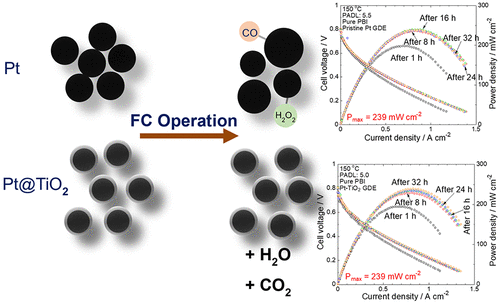当前位置:
X-MOL 学术
›
ACS Appl. Energy Mater.
›
论文详情
Our official English website, www.x-mol.net, welcomes your
feedback! (Note: you will need to create a separate account there.)
Preparation and Characterization of Stable and Active Pt@TiO2 Core–Shell Nanoparticles as Electrocatalyst for Application in PEMFCs
ACS Applied Energy Materials ( IF 5.4 ) Pub Date : 2020-03-30 , DOI: 10.1021/acsaem.9b02169 Pascal Nbelayim , Yuya Ashida , Keiichiro Maegawa , Go Kawamura , Hiroyuki Muto , Atsunori Matsuda
ACS Applied Energy Materials ( IF 5.4 ) Pub Date : 2020-03-30 , DOI: 10.1021/acsaem.9b02169 Pascal Nbelayim , Yuya Ashida , Keiichiro Maegawa , Go Kawamura , Hiroyuki Muto , Atsunori Matsuda

|
PEMFCs are an established viable sustainable source of energy, especially for key sectors such as transportation and stationary and portable plants. Pt is their best performing electrocatalyst. However, Pt is affected by stability and durability issues from corrosion, leaching, particle size growth, poisoning, and deleterious byproducts effects. One promising approach to meeting these challenges is the use of metal oxides because of their high chemical and electrical stability. They are usually used in the form of composites or as support materials with some successes but with accompanying challenges of reduced surface area and parts of the surface of the active catalyst NPs still bare, exposing them to some levels of poisoning, leaching, and particle size growth. Hence, in this work Pt@TiO2 core–shell NPs were prepared, with the surface of the Pt completely covered by TiO2 to combat these challenges. Uniform size and shape Pt@TiO2 NPs, with Pt cores of 6.5 nm and TiO2 shells of 0.5 nm, were obtained using a microemulsion/sol–gel method and hot water treatment, with bare Pt and TiO2 NPs as controls. Heat treatment at various temperatures showed negligible NP size change up to 300 °C but effective particle size growth suppression by the TiO2 at ≥400 °C. The NPs showed BET SAs in the order TiO2 (137) > Pt@TiO2 (78) > Pt (16.3 m2/g), with their corresponding ECSAs as 0.02, 4.24, and 8.52 m2/g, respectively. A preliminary FC performance evaluation to investigate the feasibility of these NPs as electrocatalysts showed that Pt@TiO2 had the best performance and stability, compared to even a commercial catalyst, with power generations of 239, 239, and 257 mW/cm2 at 150 °C for Pt, Pt@TiO2, and commercial catalyst, respectively. These results show a significant viable new approach for the application of metal oxides for durable FCs and present new research opportunities.
中文翻译:

稳定,活性的Pt @ TiO 2核壳纳米粒子的制备及其电催化剂在PEMFC中的应用
PEMFC是一种已确立的可行的可持续能源,特别是对于运输,固定和便携式工厂等关键部门而言。铂是它们性能最好的电催化剂。但是,Pt受腐蚀,浸出,粒度增长,中毒和有害副产物影响的稳定性和耐久性问题的影响。应对这些挑战的一种有前途的方法是使用金属氧化物,因为它们具有很高的化学和电稳定性。它们通常以复合材料的形式使用或用作载体材料,虽然取得了一些成功,但伴随着减少表面积和活性催化剂NP的部分表面仍然裸露的挑战,使它们暴露于一定程度的中毒,浸出和粒径增长。因此,在这项工作中Pt @ TiO 2制备了核-壳NP,Pt的表面完全被TiO 2覆盖以应对这些挑战。使用微乳液/溶胶-凝胶法和热水处理,以裸露的Pt和TiO 2 NPs为对照,可获得尺寸和形状均匀的Pt @ TiO 2 NPs,Pt核心为6.5 nm,TiO 2壳层为0.5 nm 。在不同温度下进行的热处理表明,在300°C以下时NP尺寸变化可忽略不计,但是在≥400°C时TiO 2有效抑制了粒径的增长。NPs的BET SAs依次为TiO 2(137)> Pt @ TiO 2(78)> Pt(16.3 m 2 / g),其对应的ECSA为0.02、4.24和8.52 m 2/ g。初步的FC性能评估研究了这些NPs作为电催化剂的可行性,结果表明,与市售催化剂相比,Pt @ TiO 2具有最佳的性能和稳定性,在150瓦时的发电量为239、239和257 mW / cm 2。 Pt,Pt @ TiO 2和市售催化剂的°C分别。这些结果显示了将金属氧化物用于耐久FC的重要可行新方法,并提供了新的研究机会。
更新日期:2020-03-30
中文翻译:

稳定,活性的Pt @ TiO 2核壳纳米粒子的制备及其电催化剂在PEMFC中的应用
PEMFC是一种已确立的可行的可持续能源,特别是对于运输,固定和便携式工厂等关键部门而言。铂是它们性能最好的电催化剂。但是,Pt受腐蚀,浸出,粒度增长,中毒和有害副产物影响的稳定性和耐久性问题的影响。应对这些挑战的一种有前途的方法是使用金属氧化物,因为它们具有很高的化学和电稳定性。它们通常以复合材料的形式使用或用作载体材料,虽然取得了一些成功,但伴随着减少表面积和活性催化剂NP的部分表面仍然裸露的挑战,使它们暴露于一定程度的中毒,浸出和粒径增长。因此,在这项工作中Pt @ TiO 2制备了核-壳NP,Pt的表面完全被TiO 2覆盖以应对这些挑战。使用微乳液/溶胶-凝胶法和热水处理,以裸露的Pt和TiO 2 NPs为对照,可获得尺寸和形状均匀的Pt @ TiO 2 NPs,Pt核心为6.5 nm,TiO 2壳层为0.5 nm 。在不同温度下进行的热处理表明,在300°C以下时NP尺寸变化可忽略不计,但是在≥400°C时TiO 2有效抑制了粒径的增长。NPs的BET SAs依次为TiO 2(137)> Pt @ TiO 2(78)> Pt(16.3 m 2 / g),其对应的ECSA为0.02、4.24和8.52 m 2/ g。初步的FC性能评估研究了这些NPs作为电催化剂的可行性,结果表明,与市售催化剂相比,Pt @ TiO 2具有最佳的性能和稳定性,在150瓦时的发电量为239、239和257 mW / cm 2。 Pt,Pt @ TiO 2和市售催化剂的°C分别。这些结果显示了将金属氧化物用于耐久FC的重要可行新方法,并提供了新的研究机会。











































 京公网安备 11010802027423号
京公网安备 11010802027423号